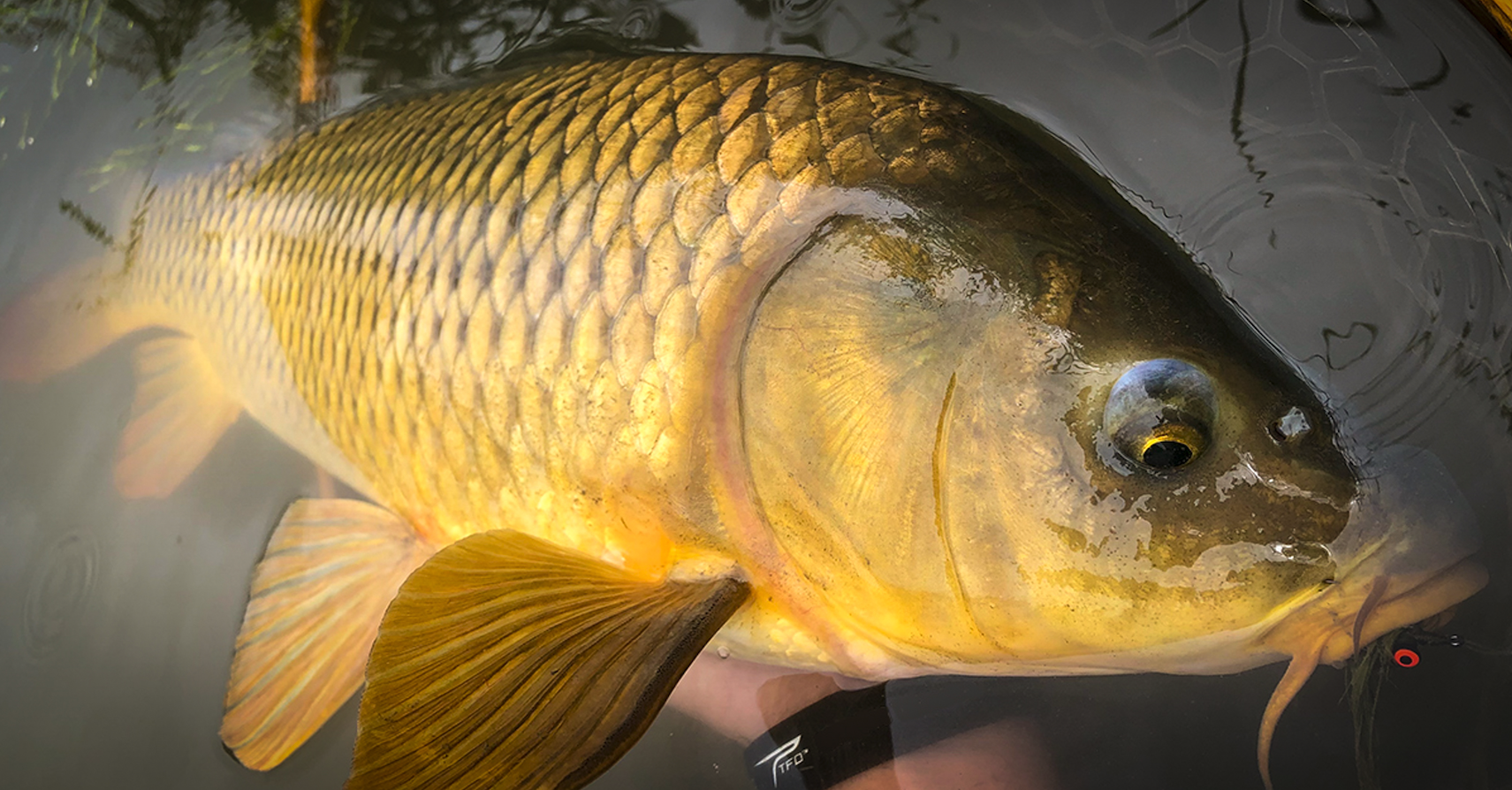Carp on the fly is completely and utterly underrated! If you haven’t ever chased carp with a fly rod, you are seriously missing out on some of the most fun that you could ever have with a fly rod. These massive fish will test your patience, presentation, gear, and knot-tying skills. Once you get out there and try it, I can guarantee that you will be hooked! It is relatively easy to get started because most of your local waters probably already have a thriving carp population. In this write-up, we will go over the rod, leader, and line set up that I personally use, along with the tactics, flies, and approach that have scored me some big ones!

Photo: Ryan Rachiele
Stealth/Approach
Carp have an incredible sense of sight, and they also are highly sensitive to even the slightest vibrations on the water. The slightest misstep or slip up on your approach can send the carp jetting off leaving you with nothing but a big mud cloud. Stacking the odds in your favor can increase your chances of having a successful day on the water. Here are a few personal tips to up your stealth game/approach:
- Be like a statue. Carp have a wide angle of vision and they are always on the lookout for danger. Thus, making the least amount of movement as possible is a must! The carp has a small blind spot that is directly behind them, I repeat this is a very small blind spot. Because of this I like to use an upstream approach, this way, I am less likely to spook the fish.
- Clothing is highly important for your approach – make sure to wear natural colors. Colors such as black, brown, or green are the best. I’m not saying that you need to go out and buy a ghillie suit, just don’t expect to be very stealthy in fluorescent orange!
- 9 times out of 10 your first cast is going to be your only cast. So, your presentation better be on point because you won’t get another chance at the same fish. Practice casting while you are crouching or on your knees, because, most of the time this will be the position you will be casting in.
- Spotting a feeding carp can be easy most of the time because of the mud cloud that they create while feeding. Once you spot a feeding carp you need approach slow, and as methodically as possible. Once you are in a casting position you need to target the area that is a few inches ahead of the carp’s feeding lane. Once you make the cast slowly bounce your pattern in front of the fish, the fly should then catch his attention. Sometimes you will not be able to see them eat your fly so keep on stripping until you feel resistance, once you do HOLD ON TIGHT!

Photo: Ryan Rachiele
Flies
Carp feed on a variety of prey items, such as, insects, crustaceans, and crayfish. Crayfish and Damsel Nymphs are my personal favorite patterns to use for carp. Try to make sure to pick fly patterns that can get down right in front of the fish, but, are not so heavy that they make a splash and spook every fish you cast for. Carp flies should be simple. Using materials like rabbit strips or marabou will provide movement with little effort on your part. Here are a few of my personal favorite carp patterns:
- Whitlock’s Near Nuff Crayfish
- Bartlett’s Hybrid
- Marlock’s Carp Breakfast
- Reynold’s Carp Bitter

Photo: Ryan Rachiele
Rod/Reel Setup
These fish have some serious torque that will test your gear and your fish fighting skills. A 7wt rod is the best overall fly rod to use, and will handle most of the situations that you will find yourself in. Sometimes, when I plan on fishing for smallmouth as well, I will use an 8wt. I use two different fly rods throughout the season, the first is the TFO Mangrove 7wt and the second is the TFO LK Legacy 7wt. Both rods give me the delicate presentation I need, but still have the backbone needed to handle the rod bending carp. With most fish, your reel is basically a line holder, I rarely, if ever, put a big trout or a bass on the reel, because, most of the time there is no need to. However, with carp, your reel is going to be one of the most important parts of your setup. You want a lightweight reel with a flawless sealed drag system. I use the TFO BVK SD III and it withstands the relentless abuse that I put it through season after season.

Photo: Ryan Rachiele
Fly Line/Leader Setup
A weight forward floating fly line will be the most versatile line to use. I personally find an intermediate or sink tip line to be too much. As far as leader goes a 9-foot fluorocarbon leader tapered down to a 12-pound test will do the job. I use a 12-pound test because it is strong enough to handle the big fish, but, not too thick that it spooks every fish.
I can promise you that once your hooked into a monster carp and you feel the fly line to backing knot slide through your fingers and it is still going, you will give carp an all new respect. You can blame me when carp becomes your new obsession!
Blog written by TFO Ambassador Ryan Rachiele (Instagram: @streamerjunkie17). When not fishing, you can also find him working at Wellsboro, Pennsylvania shop Wellsboro Tackle Shack. Find out more about Ryan here.

Photo: Ryan Rachiele
![]()






